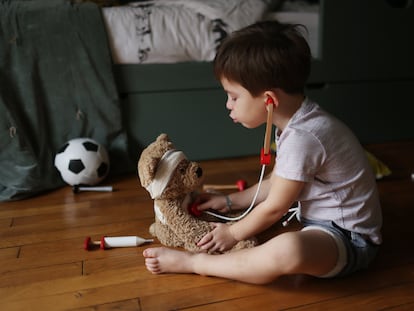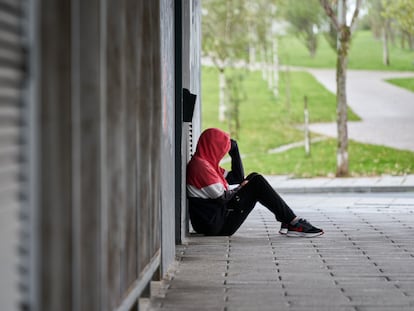Children no longer play out on the street. This is a mistake
Today’s urban planning trends leave minors out of the equation and generate parental overprotection. This prevents kids from developing their autonomy and a sense of belonging to a community

Approximately 1 billion minors live in cities, according to UNICEF data. These are environments that, despite the possibilities of development and protection that they could offer to the child population, do not live up to expectations. This is what the thinker and educational psychologist Francesco Tonucci says when he asserts that cities are designed taking adults as a reference. Tonucci proposes that minors should be able to go out alone in safe environments, because if this is the case, they will also be safer places for adults.
Given the disconnect between cities and childhood, there are many who consider it necessary to achieve a union again. “For a long time this group [the child population] has remained invisible to various disciplines and agents,” says Ana Novella Cámara, coordinator of the European IMCITIZEN Project, a University of Barcelona program that “fosters children’s democratic citizenship identity as active and engaged members of their municipalities.”
Starting in the 1990s, with the approval of the Convention on the Rights of the Child in November 1989, childhood became visible as a subject with rights to foster, guarantee and defend. The international movement of Educating Cities, that same decade, triggered a change in the conception of the city as an agent of training and an educational space defined collaboratively by all citizens. This modification of criteria coincided with Tonucci’s denunciation of the hostility of cities towards childhood in his book The City of Children (1996). “The author points directly to the responsibility of politicians and architects in paying attention to the perspectives of childhood when they are defining play spaces and organizing the city. The fundamental premise is to recognize children as active agents in urban planning and in the configuration of the city, promoting a more inclusive approach that is sensitive to their needs,” explains Novella.
The Spanish 20th-century architect Fernando Chueca, in his book Brief History of Urban Planning, stated that the city is a physical organization with a soul. “We citizens have the right and the duty to contribute that soul, nourished by human sensitivity. And childhood? Its role in the ideation of the city is very convenient, although historically it has been underestimated,” says Pablo Campos Calvo-Sotelo, a professor of architectural composition at the San Pablo-CEU University in Madrid. The participation of boys and girls in the configuration of the city is essential. “They are users, unique but very authoritative, and they will be in charge of living it and improving it as it matures,” says Campos. Furthermore, according to this expert, children have the ability to offer different perspectives that can serve as inspiration to reinvent urban environments: “As a public setting, the city is the macro-scale projection of the family home; therefore, the youngest, with their way of living and psychologically perceiving space, must be listened to. The city is the constructed metaphor of a society that welcomes us all.”
The most profound change that the city has suffered in connection with the presence of minors is the loss of autonomy in the use and enjoyment of its streets. “We have gone from a visible childhood that was part of the urban landscape, to a confined childhood, either at home or in limited and exclusive spaces, and always under adult surveillance,” says Marta Román, a geographer and founder of Gea21, a consulting company. This silent process of childhood invisibility is supported by “urban planning aspects — control of traffic and growth of distances; demographics — very low birth rates; and social — a profound change in the way of conceiving and treating minors. Hyperprotection violates children’s basic rights and is at the origin of many of the problems that plague children and teenagers today,” says Román.
The paradigm shift in connection with the city-childhood binomial has made the city go from being a common heritage, where the neighborhood contributed to children’s care, to becoming “a private asset where the family is the only legitimized reference,” says Román. The emptying out of public space — with fewer and fewer activities and uses — the housing models that turn their backs on the street and the predominance of cars and other private uses occupying the common space, “have been gradually expelling children and young people from the streets,” she says. “For this reason, we must once again convert the city into a scenario of coexistence, where children can be integrated into a safe place where they can move autonomously and develop responsible behavior and values, because the city also educates,” says Campos.
Parents have a crucial role to play so that children do not limit themselves to inhabiting the city, but rather live fully in it. “Establishing a co-responsible and emotional bond with the streets is revealed as a fundamental pillar for their comprehensive development, avoiding the overprotection that limits their presence on the street and avoiding transferring our own fears and insecurities with public space onto them,” says Novella. To achieve this approach, the IMCITIZEN project coordinator advises:
- Transmit positive emotions and feelings in relation to public space.
- Occupy the streets as a space for play and discovery. Use the street space to have fun with other girls and boys.
- Explore spaces together. Accompany your daughters and sons while they explore the different corners of the neighborhood, and gradually withdraw to promote their autonomy, freedom and sense of security.
- Enjoy public spaces as spaces of relationship and culture.
- Participate in community spaces where you can get involved in events and initiatives that energize the community.
- Weave a network of proximity based on trust. Recognize and strengthen mutual trust with the environment and the community.
The neighborhood and the municipality are thus configured as an essential element in the development of childhood. “Childhood that develops outside the neighborhood lacks ties that contribute to establishing a solid connection with the environment,” says Novella. This distancing can generate feelings of disaffection and little interest in what is happening in the locality. Therefore, it is essential to weave bonds of belonging from an early age to promote the development of identity in a connected and active way. Because, according to this expert, growing up as an alien in the space where you live has its consequences:
- Children are deprived of opportunities for diverse and meaningful experiences with the community and with other children.
- Children lack social and community references. It could become difficult to establish friendships.
- It increases screen time and consequently sedentary habits.
- Children develop suboptimal social skills for interacting with other people and lead community initiatives that energize the environment.
- It reduces their knowledge of services in the neighborhood and of the activities and traditions of the territory.
On the contrary, when children are more integrated into the neighborhood:
- It increases their sense of belonging and construction of a cultural identity rooted in an environment.
- It provides a wide horizon of opportunities and diverse experiences that expands their autonomy and freedom.
- It fosters high-intensity citizenship skills that connect them with others.
- It expands their social circle, creating a larger group of friends and acquaintances with whom they can interact in various activities.
- It fosters self-esteem by having a large group that allows them to do things together for their community.
- It encourages healthy habits, reduces the feeling of loneliness and, therefore, can also reduce mental health problems.
Another factor that helps boys and girls “experience” their city is playtime. “The recreational component must take center stage,” Campos continues, “the city must offer the child functional and architectural diversity so that they can build, just as in the family home, feelings of belonging.”
Sign up for our weekly newsletter to get more English-language news coverage from EL PAÍS USA Edition
Tu suscripción se está usando en otro dispositivo
¿Quieres añadir otro usuario a tu suscripción?
Si continúas leyendo en este dispositivo, no se podrá leer en el otro.
FlechaTu suscripción se está usando en otro dispositivo y solo puedes acceder a EL PAÍS desde un dispositivo a la vez.
Si quieres compartir tu cuenta, cambia tu suscripción a la modalidad Premium, así podrás añadir otro usuario. Cada uno accederá con su propia cuenta de email, lo que os permitirá personalizar vuestra experiencia en EL PAÍS.
¿Tienes una suscripción de empresa? Accede aquí para contratar más cuentas.
En el caso de no saber quién está usando tu cuenta, te recomendamos cambiar tu contraseña aquí.
Si decides continuar compartiendo tu cuenta, este mensaje se mostrará en tu dispositivo y en el de la otra persona que está usando tu cuenta de forma indefinida, afectando a tu experiencia de lectura. Puedes consultar aquí los términos y condiciones de la suscripción digital.
More information
Últimas noticias
Most viewed
- Sinaloa Cartel war is taking its toll on Los Chapitos
- Oona Chaplin: ‘I told James Cameron that I was living in a treehouse and starting a permaculture project with a friend’
- Reinhard Genzel, Nobel laureate in physics: ‘One-minute videos will never give you the truth’
- Why the price of coffee has skyrocketed: from Brazilian plantations to specialty coffee houses
- Silver prices are going crazy: This is what’s fueling the rally










































